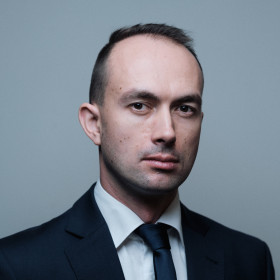Damian Markowski - Instytut Pileckiego

Graduate of the Institute of History at the University of Warsaw (2010), and Doctor of the Humanities in the field of History at the Faculty of History of the University of Warsaw (2016). On 4 October 2024, he received the academic degree of Doctor Habilitatus in the Humanities, field of History, from the Institute of Political Studies of the Polish Academy of Sciences. He has worked at the Council for the Protection of Struggle and Martyrdom Sites, the Ministry of Culture and National Heritage, and the Institute of National Remembrance, among others. In 2022, he was employed at the Jan Karski Institute for War Losses. In August 2024, he joined the Center for Totalitarian Studies as an Adjunct. Professor Markowski collaborates with numerous national and foreign research centers, including the Institute of Political Studies of the Polish Academy of Sciences, the Museum of Polish History, and the Center for the Urban History of Central and Eastern Europe in Lviv. In the years 2014–2017, he was the substantive manager of a project concerned with uncovering the graves of Polish soldiers killed in 1939 near Lviv, titled “Guardians of National Memory” and implemented under the patronage of the Senate of the Republic of Poland.
His research interests include the history of the former Eastern Borderlands of the Second Polish Republic, with a particular focus on the first half of the 20th century and political and economic issues, the history of Russia and the Soviet Union, the process of Sovietization of Eastern Europe during the reign of Joseph Stalin, the politics of memory of European states, and Polish-Ukrainian relations.
He is the recipient of numerous domestic and international scholarships, and has completed internships and research trips in the United Kingdom, Germany, the Czech Republic, Lithuania and Ukraine, among others. Professor Markowski has received the “Przegląd Wschodni” Award (2020), the Janusz Kurtyka Award (2019) and the Award of the President of the Institute of National Remembrance (2018), and was nominated for the Tomasz Strzembosz Award (2019).
He is also the reviewer of articles published in numerous scholarly journals.
Chief publications
Monographs:
- W cieniu Wołynia. „Antypolska akcja” OUN i UPA w Galicji Wschodniej 1943–1945,
Kraków 2023, Wydawnictwo Literackie, 535 pp.;
- Zwei Aufstände. Die Schlacht um Lemberg 1918, Peter Lang, Berlin, 2021, 456 pp.;
- Lwów or L’viv? Two Uprisings in 1918, Peter Lang, Berlin 2021, 418 pp.;
(publications no. 2 and 3 are translations of the book Dwa powstania)
- Lwów 1944, Bellona, Warszawa 2021, 252 pp.;
- Dwa powstania. Bitwa o Lwów 1918. Wojna i nowoczesny konflikt pamięci,
Wydawnictwo Literackie, Kraków 2019, 475 pp.;
- Anatomia strachu. Sowietyzacja obwodu lwowskiego 1944–1953. Studium zmian polityczno-gospodarczych, Wydawnictwo Instytutu Pamięci Narodowej – Komisji Ścigania Zbrodni przeciwko Narodowi Polskiemu, Warszawa 2018, 587 pp.;
IN PREPARATION: Historia gospodarcza ziem polskich 1939–1949, tom 2: 1939–1945 (co-authored with Prof. Mirosław Kłusek), Instytut Solidarności i Męstwa im. Witolda Pileckiego, 712 pp. (manuscript), planned publication date – 2025
Chapters in monographs:
- Na drodze do nowego sowieckiego „zachodu”? Wokół problemu powtórnej sowietyzacji gospodarczej i politycznej zachodnich obwodów USRS 1944–1953, [in:] Od rewolucji do pierestrojki. Transformacje Wschodniej Europy w ostatnim stuleciu, ed. by Magdalena Gibiec, Grzegorz Hryciuk, Małgorzata Ruchniewicz, Wydawnictwo LTW, Łomianki 2022, pp. 113–137;
- From the Molotov-Ribbentrop Pact to the Territorial Agreement of “the Big Three”: Redrawing the Polish-Ukrainian Border in 1939–52, [in:] Making Ukraine. Negotiating, Contesting, and Drawing the Borders in the Twentieth Century, ed. by Olena Pal’ko, Constantin Ardeleanu, McGill-Queen’s University Press, Montreal-Kingston-London-Chicago, 2022, pp. 138–163;
- Polityka Organizacji Ukraińskich Nacjonalistów wobec ludności polskiej w latach 1939–1944. Szkic syntetyczny, [in:] Historia pisana chłopską krwią. Zamojszczyzna, Wołyń i Małopolska Wschodnia w latach II wojny światowej, ed. by Janusz Gmitruk, Muzeum Historii Polskiego Ruchu Ludowego, Warszawa 2015, pp. 105–114;
- Niezdobyty bastion. Walki o Uniwersytet Warszawski podczas powstania warszawskiego, [in:] Z dziejów Warszawy, t. I, Społeczeństwo, ed. by Michał Kopczyński and Katarzyna Wagner, Warszawa 2010;
- Zwyciężyć, czyli przetrwać. Próby radzenia sobie w powstańczej Warszawie na wybranych przykładach z życia ludności cywilnej, [in:] Z dziejów Warszawy, t. III, Przedsiębiorczość, ed. by Michał Kopczyński and Katarzyna Wagner, Warszawa 2012.
Scientific articles and reviews:
- Wielka blokada. Przeciwpartyzancka operacja sił bezpieczeństwa wewnętrznego USRR w Karpatach Wschodnich (styczeń – kwiecień 1946 r.), “Przegląd Historyczny” 2013, vol. 104, issue 4, pp. 729–748;
- Partyjne elity sowieckiego Lwowa 1944–1953. Rzecz o nowej elicie starego miasta, “Studia Polityczne” 2016, issue 4 (44), pp. 47–70;
- Review of: PRL a wojna domowa w Grecji / The Polish People’s Republic and the Greek Civil War, ed. by Magdalena Semczyszyn, transl. into English by Joanna Gołąb, Instytut Pamięci Narodowej – Komisja Ścigania Zbrodni przeciwko Narodowi Polskiemu, Szczecin 2016, pp. 272, [in:] “Rocznik Polsko-Niemiecki” 2016, no. 24, issue 2;
- Między trzema okupacjami. Bankowość okupantów na terenie przedwojennych Ziem Wschodnich 1939–1946. Zarys problematyki, “Studia nad Totalitaryzmami i Wiekiem XX” 2022, issue 6, Warszawa, pp. 98–115;
- Review of Olena Pal’ko book, Making Ukraine Soviet: Literature and Cultural Politics under Lenin and Stalin. London, Bloomsbury Academic, 2020. 280 pp.
The review was published on H-Net:
https://networks.h-net.org/node/4555727/reviews/8233756/markowski-palko-making-ukraine-soviet-literature-and-cultural
- Tarcza i miecz rewolucji. NKWD/MWD i NKGB/MGB: organy bezpieczeństwa państwowego USRS w obwodzie lwowskim, 1944–1946. Wybrane aspekty działalności, “Kwartalnik Kresowy” 2021, vol. 7, issue 2, pp. 213–234;
- Ostatni leśni czy zbrojne podziemie? Wokół charakteru działalności zbrojnej Obszaru NIE Lwów (sierpień 1944 – maj 1945 roku), “Studia i Materiały Centralnej Biblioteki Wojskowej im. J. Piłsudskiego” 2021, issue 2, pp. 127–143;
- Wołyńskie powstanie. Epopeja 27. Wołyńskiej Dywizji Piechoty AK (styczeń – kwiecień 1944 r.), “Niepodległość i Pamięć” 2013, vol. 20, issue 3–4 (43–44), pp. 141–182;
- „Odwiecznie ukraińskie miasto”. Sowiecka polityka pamięci wobec Lwowa i okolic w okresie późnego stalinizmu (1944–1953). Miejscowości, ulice, upamiętnienia, “Przeszłość i Pamięć. Biuletyn Rady Ochrony Pamięci Walk i Męczeństwa” 2013, issue 42.